Cultivars - A
Cultivars - B
Cultivars - C
Cultivars - D
Cultivars - E
Cultivars - F
Cultivars - G
Cultivars - H
Cultivars - I
Cultivars - J
Cultivars - K
Cultivars - L
Cultivars - M
Cultivars - N
Cultivars - O
Cultivars - P
Cultivars - QR
Cultivars - S
Cultivars - T
Cultivars - UV
Cultivars - W
Cultivars - XYZ
| |
|
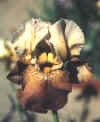 PALIMPSEST (McAllister, 1995) OGB- Soft pewter standards have brass veins radiating from the midrib. Falls are a blend of tan/rust/brown, with reddish-brown signal spot and an area around the beard where the white ground shows through. A conventional quarterbred not tested for fertility, but with a pattern that suggests trying it with tetraploid arils. Strictly for experimenters. In the days before paper was invented, writing material was precious and scrolls were prepared for reuse by scraping and bleaching them so they could be written on again. A palimpsest is one of those written-over scrolls on which earlier writings are still visible. This flower is similar to one of those written-over scrolls in that it is a planoply of colors in a series of overlaid patterns. Sostenique X Tribe of Judah. PALIMPSEST (McAllister, 1995) OGB- Soft pewter standards have brass veins radiating from the midrib. Falls are a blend of tan/rust/brown, with reddish-brown signal spot and an area around the beard where the white ground shows through. A conventional quarterbred not tested for fertility, but with a pattern that suggests trying it with tetraploid arils. Strictly for experimenters. In the days before paper was invented, writing material was precious and scrolls were prepared for reuse by scraping and bleaching them so they could be written on again. A palimpsest is one of those written-over scrolls on which earlier writings are still visible. This flower is similar to one of those written-over scrolls in that it is a planoply of colors in a series of overlaid patterns. Sostenique X Tribe of Judah.
|
|
PALLU (Rich, 1985). OGB+ S orchid-purple, texture veining; bronzy purple styles; F maroon purple, wire edging of lighter tone, black signal; orange beard. R75-97G:
(Quinta x ((Quinta x (Welcome Reward x ((Bagdad Beauty x Orchid and Flame), x Kalifa
Hirfa))) x R71-87D)) X R66-35Q: ((Kerr 54-8-0 x Judean Raven) x I. antilibanotica). |
|
PASTEL TRACERY (Rich,1990). OGB+ S. pink orchid, finely veined wine purple; brown to sorrel style arms; F. pink orchid, small halo of heavy pepper dots diminishing into light orchid veins, mulberry wine signal; orange-yellow beard. Kerr K55-9A X Welcome Reward. |
|
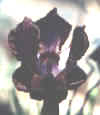 PERSIAN ACCENT (Rich, 1991). RC S. white veined bright violet, violet midrib; tan styles, orchid throat; F. gold veined brown, bright violet rose overlay flowing toward edge, large black signal; black beard. Extremely complex pedigree. My test crosses have shown this to be worth using, whether it is a relatively fertile triploid or a
tetraploid. Persian Pansy X R75-184B: (((Persian Bronze x (Kerr K55-1 x K55-14)) x
(Bagdad Beauty x (I. gatesii x I. hermona))) x I. stolonifera USSR 163). PERSIAN ACCENT (Rich, 1991). RC S. white veined bright violet, violet midrib; tan styles, orchid throat; F. gold veined brown, bright violet rose overlay flowing toward edge, large black signal; black beard. Extremely complex pedigree. My test crosses have shown this to be worth using, whether it is a relatively fertile triploid or a
tetraploid. Persian Pansy X R75-184B: (((Persian Bronze x (Kerr K55-1 x K55-14)) x
(Bagdad Beauty x (I. gatesii x I. hermona))) x I. stolonifera USSR 163). |
|
PERSIAN PADISHAH (Shockey, 1988). OGB+ Medium rose-purple, large dark purple-black signal; dark purple beard; ruffled standards. Seedling 83-111-D: (Heart Stealer X 80-21-3J (OH): ((Shah Abbas x 74-12-1) x (60-96 x Babylonian Brass))). |
|
PERSIAN PANSY (Austin, 1969) RC Pansy purple self with yellow throat, dark yellow beard, and large black signal.
A valued collectible as the first known tetraploid regeliocyclus. It has a
well-deserved reputation for producing primarily look-alikes [in my experience,
about 99 out of 100], but the available pool of tetraploid arils is so small that I still recommend Persian Pansy to anyone working with the tetraploid arils.
I. nigricans X I. hoogiana Late Amethyst. |
|
PERSIAN QUEST (Foster, 1969). OGB+ Light amethyst violet self, veined darker, deep amethyst violet signal, pale violet style arms, gold beard. Persian Pansy X unknown C.G. White type
arilbred. |
|
PERSIAN STAR (Foster, 1969). OGB+ S spectrum violet, finely veined; F same, veining and netting, recurved; golden bronze beard, shiny black signal. Persian Pansy X unknown C.G. White type
arilbred. |
|
PINK BETTERMENT (Peterson, 1984) OGB Rich pink standards have faint lavender overlay. Falls are slightly darker, with a near-black beard. A fully fertile halfbred, which I recommend for beginners. Useful in work with pinkish lines. Esther's Son X Heart Stealer. |
|
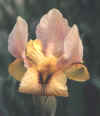 PIXILATED (McAllister, 1996) OGB-. A funny thing happened along the road to pink: pink and yellow blends. Not the usual ones of pinkish blush over yellow ground, but interspersed dots of pink and yellow pigments that show up under a magnifying glass, like the pixels on a computer screen. Standards are a soft blend of pink and yellow, blushed with pale pinkish lavender, held open by strong midribs to showcase the clear, bright lemon yellow style arms. Falls are lemon yellow, lightly blushed pinkish violet, with a dark burgundy spot surrounding a bright yellow-orange beard and several burgundy lines extending downward from it's tip. A ¼-bred that's partially fertile both ways and appears to be a significant step toward combining tangerine pigments and aril characteristics. I coined the term
"pixelated" to describe the pattern, but it was disallowed. "Pixilated", meaning slightly tipsy, comes close and won the Name Game for Samuel Norris in 1995. Altogether Lovely X Persian Smoke. PIXILATED (McAllister, 1996) OGB-. A funny thing happened along the road to pink: pink and yellow blends. Not the usual ones of pinkish blush over yellow ground, but interspersed dots of pink and yellow pigments that show up under a magnifying glass, like the pixels on a computer screen. Standards are a soft blend of pink and yellow, blushed with pale pinkish lavender, held open by strong midribs to showcase the clear, bright lemon yellow style arms. Falls are lemon yellow, lightly blushed pinkish violet, with a dark burgundy spot surrounding a bright yellow-orange beard and several burgundy lines extending downward from it's tip. A ¼-bred that's partially fertile both ways and appears to be a significant step toward combining tangerine pigments and aril characteristics. I coined the term
"pixelated" to describe the pattern, but it was disallowed. "Pixilated", meaning slightly tipsy, comes close and won the Name Game for Samuel Norris in 1995. Altogether Lovely X Persian Smoke. |
|
POGO DOLL (Christlieb, 1974). OGB- S greyed lavender; F ochre edged gold, brow line halo around amber beard, tipped wine; blue shadow signal. An arilbred median from Pogo X Kalifa
Hirfa. |
|
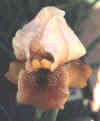 POINT WELL TAKEN (McAllister, 1998) OGB Pinkish-ivory standards are lightly veined golden yellow. Golden tan falls are heavily stippled with rust around the beard, while a rust wash extends over the blade. A dime-size brownish-black signal is almost lost in the intricate needlepoint-inlay effect of the other markings. "Needlepoint" had already been taken, but the point pattern was well-defined and a bit of word-association led to this phrase. Sandy Dandy X Whirlwind Romance. POINT WELL TAKEN (McAllister, 1998) OGB Pinkish-ivory standards are lightly veined golden yellow. Golden tan falls are heavily stippled with rust around the beard, while a rust wash extends over the blade. A dime-size brownish-black signal is almost lost in the intricate needlepoint-inlay effect of the other markings. "Needlepoint" had already been taken, but the point pattern was well-defined and a bit of word-association led to this phrase. Sandy Dandy X Whirlwind Romance. |
|
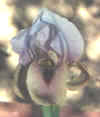 PRECIOUS MEMORIES (Hunt-McAllister, 1987) OGB+ Wisteria violet standards; greyed yellow falls, blushed rose-pink. Velvety signal of deep burgundy. Presumably triploid, from Teucros X Fourteen for Rachel. It has produced a few seedlings for me, but none of them have survived to bloom size. This seedling was special to me, personally, because it was the last one that Gene sent to me as a guest before his death. It's also a special iris, with a textured signal rarely found in
arilbreds. With Gene's tradition of using Biblical names for his iris, the title of the old gospel tune seemed like a perfect "fit". PRECIOUS MEMORIES (Hunt-McAllister, 1987) OGB+ Wisteria violet standards; greyed yellow falls, blushed rose-pink. Velvety signal of deep burgundy. Presumably triploid, from Teucros X Fourteen for Rachel. It has produced a few seedlings for me, but none of them have survived to bloom size. This seedling was special to me, personally, because it was the last one that Gene sent to me as a guest before his death. It's also a special iris, with a textured signal rarely found in
arilbreds. With Gene's tradition of using Biblical names for his iris, the title of the old gospel tune seemed like a perfect "fit". |
|
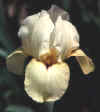 PRIM AND PROPER (McAllister, 1994) OGB+ Clean white standards. Primrose yellow falls sharply accented by an arrowhead-shaped near-black signal. This ¾-bred is unusually fertile for the type, although not as fertile as the ½-breds. It has already proven valuable to me in work with the Triploid Route. Still another double-meaning, in that "Prim" is short for primrose and "Proper" describes its classic smooth, rounded form and prominent signal – but taken together they form a phrase that depicts the overall impression. Wished for Child X I.
kirkwoodii. PRIM AND PROPER (McAllister, 1994) OGB+ Clean white standards. Primrose yellow falls sharply accented by an arrowhead-shaped near-black signal. This ¾-bred is unusually fertile for the type, although not as fertile as the ½-breds. It has already proven valuable to me in work with the Triploid Route. Still another double-meaning, in that "Prim" is short for primrose and "Proper" describes its classic smooth, rounded form and prominent signal – but taken together they form a phrase that depicts the overall impression. Wished for Child X I.
kirkwoodii. |
|
PRODIGAL SON (Hunt, 1987) OGB+ A very masculine flower: luminous deep violet standards; iridescent deep purple falls; mustard beard and large, velvety purple-black signal. Presumably triploid, from Martha Mia X (I. samariae x Judean Charmer). Has produced a few seeds, which I've cultured, but none of its seedlings have survived to bloom size. Gene kept meticulous garden records, but he hadn't anticipated that encounter with a drunk driver or expected someone else to have to interpret his notes and labels. The garden label for this seedling didn't carry a selection number, so I treated it as one of the seedlings that were ready for final evaluation. Further study of the garden records, however, showed that it (and its sib, Thine the Glory) were two previously unaccounted for selected seedlings. The parable of the Prodigal Son seemed appropriate. |
|
PROLIFIC (Clark, 1966). OGB+. S light creamy pink; F henna brown with huge signals of deeper brown. Clark seedling: (light blue seedling x Kerr 53-44) X Clark seedling: (Kalifa Baltis x Jallah Effendi. |
|
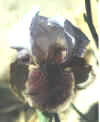 PRO NEWS (Danielson, 1984) OGB S lavender, veined darker; F buff-green edged gold, green-buff styles. Pleasure Ahead X Dee mouse. PRO NEWS (Danielson, 1984) OGB S lavender, veined darker; F buff-green edged gold, green-buff styles. Pleasure Ahead X Dee mouse.
|
|
 PROMENADE LADY (Flanagan, 1988) OGB- Light golden beige standards. Yellow-based falls have bright orange-red overlay extending from pale orange beard almost to the edge, leaving a rim of yellow. Has set seeds to Joint Venture pollen in the only test I've made of its fertility. Mistress X Caravan Trail. PROMENADE LADY (Flanagan, 1988) OGB- Light golden beige standards. Yellow-based falls have bright orange-red overlay extending from pale orange beard almost to the edge, leaving a rim of yellow. Has set seeds to Joint Venture pollen in the only test I've made of its fertility. Mistress X Caravan Trail. |
|
PROMISE OF LOVE (Hunt-McAllister, 1991) OGB White standards are flushed yellow-green at the base. Chartreuse falls have olive veining. Medium blue beard is tipped mustard. Not as fully fertile as most halfbreds, but more fertile than any other arilbredmedian that I've tried except Gene's Little Secret. Nothing in the description explains the name, does it? The word "Promise" often appears in the names of iris I introduced for Gene, because I'd promised his family I'd see that the seedlings he'd selected were duly registered and introduced. This particular phrase comes from an old hymn. |
|
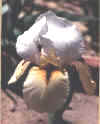 PROMISE TO ELIZABETH (Hunt, 1984) OGB Milk-white standards over honey-yellow falls. Russet beard and V-shaped signal spot. An excellent parent for all shades of white, ivory and yellow grounds – including those with a variety of brown markings. A fully fertile halfbred from the Triploid Route that I recommend highly for beginners. This should have been easy to name, with its milk-white standards and honey-yellow falls, russet beard and V-shaped signal spot – but it turned into quite a challenge. I found name after name that seemed appropriate, yet when I checked each of them it had already been used. Finally, going back through Gene's notebook for what seemed like the thousandth time, I noticed the name "Elizabeth" penciled in the margin next to this seedling on one of his maps. The name itself had already been used, of course, and I had no way of knowing what variation he'd had in mind, but this seemed to fit and was available so I decided it must have been preordained. Martha Mia X Wiloh's White Magic. PROMISE TO ELIZABETH (Hunt, 1984) OGB Milk-white standards over honey-yellow falls. Russet beard and V-shaped signal spot. An excellent parent for all shades of white, ivory and yellow grounds – including those with a variety of brown markings. A fully fertile halfbred from the Triploid Route that I recommend highly for beginners. This should have been easy to name, with its milk-white standards and honey-yellow falls, russet beard and V-shaped signal spot – but it turned into quite a challenge. I found name after name that seemed appropriate, yet when I checked each of them it had already been used. Finally, going back through Gene's notebook for what seemed like the thousandth time, I noticed the name "Elizabeth" penciled in the margin next to this seedling on one of his maps. The name itself had already been used, of course, and I had no way of knowing what variation he'd had in mind, but this seemed to fit and was available so I decided it must have been preordained. Martha Mia X Wiloh's White Magic. |
|
PROPHETIC MESSAGE (Nichols, 1979) OGB- Violet standards, tan falls blended violet. An arilbredmedian of quarterbred breeding, from which we would not expect fertility – yet it has produced seedlings when crossed with Gene's Little Secret. On maiden bloom they were nice, but not outstanding. Puppet X Esther the Queen. |
|
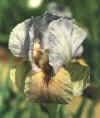 PROUD PAPA (McAllister, 1992) OGB+ Not a masculine flower: white ground standards, veined pale pinkish violet; soft yellow ground falls, faintly washed with violet to produce a blend of pink and yellow. So why such a masculine name? From its pedigree (Persian Pansy X Heart Stealer), it had to be registered as an OGB+, a category that's usually presumed infertile. Although it's presumably an unbalanced tetraploid, and has never set a pod for me, it's a surprisingly enthusiastic pollen parent that has produced a number of seedlings when crossed onto halfbreds and TBs. As is typical for this type of cross, relatively few of them have survived to bloom size – but I wanted a name that would reflect its unusual proclivity for parenthood. PROUD PAPA (McAllister, 1992) OGB+ Not a masculine flower: white ground standards, veined pale pinkish violet; soft yellow ground falls, faintly washed with violet to produce a blend of pink and yellow. So why such a masculine name? From its pedigree (Persian Pansy X Heart Stealer), it had to be registered as an OGB+, a category that's usually presumed infertile. Although it's presumably an unbalanced tetraploid, and has never set a pod for me, it's a surprisingly enthusiastic pollen parent that has produced a number of seedlings when crossed onto halfbreds and TBs. As is typical for this type of cross, relatively few of them have survived to bloom size – but I wanted a name that would reflect its unusual proclivity for parenthood. |
|
 PURE AT HEART (McAllister, 1994) OGB Snow-white standards marked with violet plicata-like stitching around the edges. Yellowish-ivory falls have heavy burgundy dotting and veining underlying a mustard and maroon beard, with finer veining extending out over the blade. In contrast to the very "busy" pattern of the standards and falls, the style arms are a clear, bright yellow. This gives the flower a striking inner glow. From a line of intricate pastel patterns that I expect to produce even more surprises in the next generation. "Pure at Heart" is both a literal description of the color and an overall impression of the flower. PURE AT HEART (McAllister, 1994) OGB Snow-white standards marked with violet plicata-like stitching around the edges. Yellowish-ivory falls have heavy burgundy dotting and veining underlying a mustard and maroon beard, with finer veining extending out over the blade. In contrast to the very "busy" pattern of the standards and falls, the style arms are a clear, bright yellow. This gives the flower a striking inner glow. From a line of intricate pastel patterns that I expect to produce even more surprises in the next generation. "Pure at Heart" is both a literal description of the color and an overall impression of the flower. |
|
PURPLE HEART IMPRESSION (Danielson, 1997). OGB+ S light lavender veined darker, lighter laender midrib tinged green; style arms light lavender, deep violet near anthers; F light lavender, white hairline edge, sparse dark violet veining, violet signal; beards slate effect, hairs green, yellow and white tiped violet; pronounced sweet fragrance. ((Tul Kerem x Kalifa Gulnare) x (A 86-2 LD, parentage unknown, x Sand and Snow)) X ((Tul Kerem x (I. camillae x Judean Pixie)) x ((Shah Abbas x Fairy Fantasy)). |
|